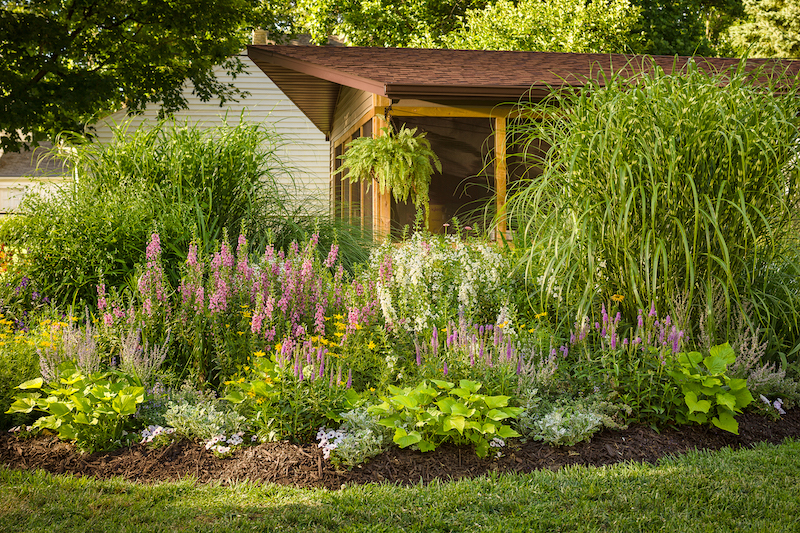Snapdragons are a beloved old-fashioned flower straight out of Grandma's cottage garden. The tall flower spikes bloom for an exceptionally long period from spring to the first frost in fall. Snapdragons can be incorporated into just about any garden design to add not only color but also vertical interest and nectar for beneficial pollinators.
Snapdragons are not picky about soil conditions and will tolerate everything from heavy clay to sandy soil. The plants bloom best with at least 6 hours of direct sun exposure, but they will grow equally well in a partially shaded location, making them able to be paired with a wide range of landscape plants.

Shrubs To Plant With Snapdragons
Snapdragons look fabulous when combined with broadleaf evergreen shrubs that act as a backdrop for their brightly colored flower spikes. Some favorites for foundation plantings include choisya, pieris, pittosporum, and euonymus, which can be enlivened for the summer with a front planting of Snapdragons. Early blooming deciduous shrubs, such as forsythia, lilacs, tricolored willow, and witch hazel, also make a good backdrop for Snapdragons, even after they have finished blooming for the season.
Perennials To Plant With Snapdragons
Snapdragons not only have a stunning presence in a flowerbed, but they are also important for attracting beneficial pollinators to the garden throughout the growing season. Some of the best perennials to pair with Snapdragons are natives and early bloomers. For early blooms, try placing snapdragons between tall foxgloves and shorter dianthus. Native yarrow, echinacea, penstemon, speedwell, and rudbeckia have long blooming periods through the summer and look nice with Snapdragons. Snapdragons are such long bloomers that they easily mix with mums, asters, and ornamental grass for fall interest.
Snapdragons are great space fillers as perennials die back for dormancy. Early bloomers like bleeding heart, columbine, and spring bulbs start to fade after blooming and may look tattered. Planting Snapdragons near the plants or in front of them can help camouflage dying stems and foliage until they are ready to be cut back.

Photo by K M, unmodified, Flickr, copyright CC BY 2.0
Annuals To Plant With Snapdragons
Most people grow Snapdragons as an annual plant, even though they are a tender, short-lived perennial. That means that in the warmer growing regions of the United States, Snapdragons may grow for a few years, but their vigor and reliability will wane after 2-3 years. Luckily, Snapdragons often self-seed and may reappear year after year if the new seedlings are not weeded out during spring clean-up.
Plant Snapdragons among other reliable self-seeding annuals for a low-maintenance and naturalistic garden design. Some great options include nasturtium, cosmos, zinnias, and calendula, which all grow well with Snapdragons and bloom all summer long. Snapdragons can also be combined with tropical annuals like sweet potato vine, bacopa, petunia, and annual phlox for a more refined and tamed display from spring until fall.
Best Companion Plants For Snapdragons in Containers
Growing Snapdragons in containers is the perfect solution for tiny gardens, decks, or patio gardens. Mixing and matching a wide variety of annuals with Snapdragons will allow a gardener to change a planter regularly to reflect the seasons.
One of the best combinations for a stunning planter display includes Snapdragons in cooling purple shades mixed with other calming annuals like calibrachoa, licorice plant, nemesia, petunias, and annual baby’s breath to fill in any gaps. Place this planter in a location that receives 6 hours of early or late sun with shelter from the midday sun to keep it looking fresh.

Plants Not To Grow With Snapdragons
Snapdragons like soil that drains well but remains moist. Planting them too close to drought-tolerant shrubs will make it difficult to keep all the plants happy. Snapdragons planted near evergreen conifers or large established trees will likely not flower well due to a lack of moisture.
The other extreme is soggy soil, which is also not suitable for Snapdragon growth. Streamside, bog, and aquatic plants, such as Siberian iris, marsh marigolds, and cattails, require high moisture levels with minimal drainage, making growth for Snapdragons almost impossible. Avoid these water lovers when planning a garden with Snapdragons.
Best Plants To Grow With Snapdragons
Planting Snapdragons in the landscape is a great way to ensure color in the garden from spring to fall. Snapdragons pair well with many low-maintenance perennials and annuals, providing a broad palette for garden designs. Use Snagdragons in the mid-range of a deep garden border to harmonize with the blues and purples of catmint, Russian sage, artemisia, and speedwell. Add some punchy color from annuals like sweet potato, bacopa, and petunias and you will have a show-stopping display for months.
 |
Author Robbin Small - Published 9-21-2023 |




